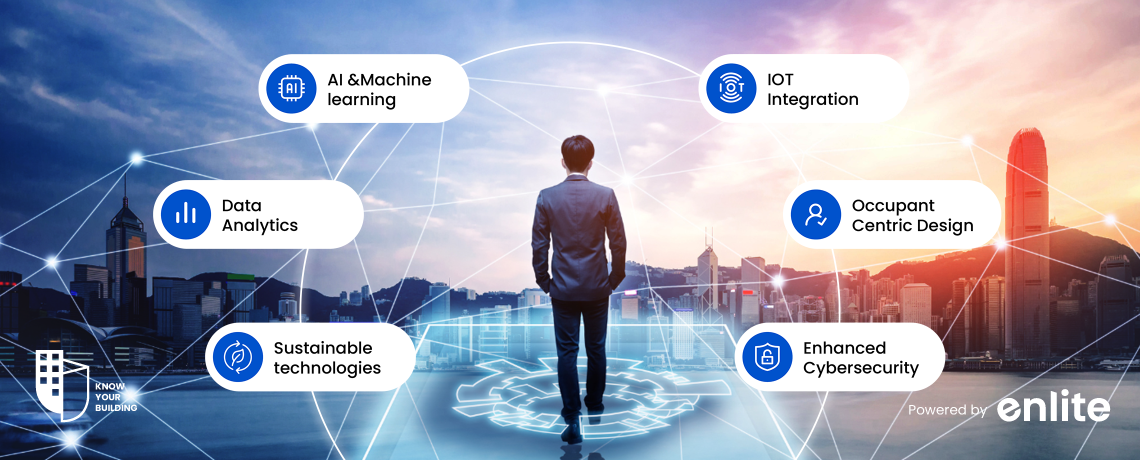The commercial real estate industry is undergoing a transformative shift, driven by rapid advancements in technology, heightened environmental concerns, and the increasing demand for smarter, more efficient buildings. At the heart of this evolution is the Building Management System (BMS), a critical component that enables the integration, automation, and optimization of various building functions. As we look ahead to the next decade, several key trends are set to redefine how BMS operates, delivering unprecedented levels of efficiency, sustainability, and occupant comfort.
Future Trends in Building Management Systems:
1. Artificial Intelligence and Machine Learning: The integration of Artificial Intelligence (AI) and Machine Learning (ML) into BMS is poised to revolutionize how buildings are managed. AI-driven BMS will be able to analyze vast amounts of data generated by building sensors, learn from patterns, and make predictive adjustments to optimize energy use, indoor air quality, and overall building performance. These systems will not only react to changes in real-time but also anticipate needs and implement proactive measures, reducing energy consumption and improving occupant comfort.
2. Internet of Things (IoT) Integration: The proliferation of IoT devices is leading to the creation of highly connected and intelligent buildings. Future BMS will leverage IoT to integrate a wide array of smart devices—ranging from lighting systems and HVAC to security cameras and access controls—into a cohesive ecosystem. This interconnected network will enable seamless communication between devices, allowing for more precise control, enhanced monitoring capabilities, and the ability to optimize building operations on a granular level.
3. Enhanced Cybersecurity Measures: As BMS becomes more sophisticated and interconnected, the need for robust cybersecurity measures will become increasingly important. Future systems will incorporate advanced encryption, secure communication protocols, and continuous monitoring to protect against cyber threats. With the rise of smart buildings, safeguarding sensitive data and ensuring the integrity of building operations will be a top priority.
4. Sustainable and Green Building Technologies: Sustainability will continue to be a driving force in the development of BMS technology. Future systems will focus on minimizing a building’s carbon footprint by optimizing energy use, integrating renewable energy sources, and enabling smarter water and waste management. As governments and organizations worldwide commit to reducing carbon emissions, BMS will play a crucial role in helping buildings achieve green certifications and meet environmental standards.
5. Occupant-Centric Design and User Experience: The future of BMS will be increasingly centered around enhancing occupant well-being and productivity. Advanced BMS will be designed to create personalized environments that adjust lighting, temperature, and air quality based on individual preferences and real-time data. This occupant-centric approach will lead to healthier, more comfortable, and more productive indoor spaces, contributing to overall workplace satisfaction.
6. Edge Computing and Data Analytics: With the vast amount of data generated by modern BMS, the need for efficient data processing is critical. Edge computing will become a key trend, allowing data to be processed locally at the source rather than relying on centralized cloud servers. This will reduce latency, enhance real-time decision-making, and improve the overall responsiveness of BMS. Coupled with advanced data analytics, this approach will provide deeper insights into building performance, enabling more informed decisions and continuous optimization.
Our Contribution: The World’s First Cloud-Native Wireless BMS
At Enlite, we are at the forefront of these emerging trends, pioneering innovations that will shape the future of Building Management Systems. Our world’s first cloud-native wireless BMS is designed to meet the demands of the next decade and beyond. Here’s how we’re leading the charge:
1. Cloud-Native Architecture: Our BMS is built on a cloud-native architecture, allowing for seamless scalability, remote management, and real-time data access from anywhere in the world. This approach not only reduces the need for on-site infrastructure but also ensures that our system can evolve with changing technological landscapes.
2. Wireless Flexibility: By eliminating the need for extensive wiring, our wireless BMS offers unparalleled flexibility in installation and operation. This makes it easier to retrofit existing buildings with smart technology, enabling older structures to benefit from modern BMS capabilities without the need for costly renovations.
3. AI and IoT Integration: We have integrated AI and IoT capabilities into our BMS, allowing for predictive maintenance, energy optimization, and personalized occupant experiences. Our system learns from data and adapts to changing conditions, ensuring that your building operates at peak efficiency while maintaining a comfortable environment for occupants.
4. Commitment to Sustainability: Sustainability is at the core of our BMS design. We prioritize energy efficiency, support the integration of renewable energy sources, and provide tools for monitoring and reducing carbon emissions. Our system helps buildings achieve green certifications, contributing to global efforts to combat climate change.
As we continue to innovate and push the boundaries of what Building Management Systems can achieve, we invite you to join us on this journey. For more details on how our world’s first cloud-native wireless BMS can transform your building operations and prepare you for the future, connect with us today.














